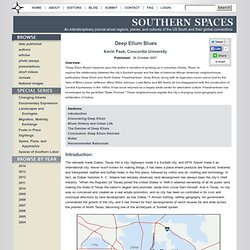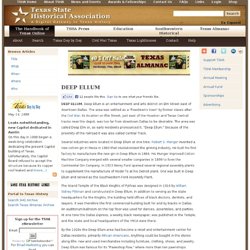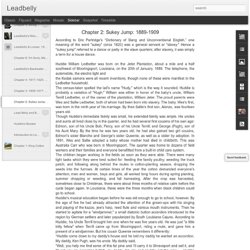

Blues Lyrics and Hoodoo. Deep Ellum Blues. This hyper-American model of speculative growth has left little room for the old, at least until very recently.

For such a young city, the new becomes the old, unwanted, and forgotten very quickly. Particularly unwanted have been the neighborhoods marked by the presence of African Americans in Dallas: Frogtown or Froggy Bottom (an early mixed neighborhood of shady character adjacent to the Trinity River and its thousands of serenading frogs), Stringtown, the North Dallas Freedmantown, and Deep Ellum have all been plowed over by development, even if the latter two have known recent re-development. Legal desegregation, in fact, only heightened this process since it made it appear even more necessary for white Dallasites to live further from the center city.
African Americans were present in the Dallas area as slaves before the Civil War (97 out of a total population of 678 in 1860), but many more arrived soon after the war, and settled in a variety of 'Freedmantowns' around the city. Dallas String Band Career. WALKER, AARON THIBEAUX [T-BONE] WALKER, AARON THIBEAUX [T-BONE] (1910–1975).
![WALKER, AARON THIBEAUX [T-BONE]](http://cdn.pearltrees.com/s/pic/th/historical-association-57624010)
T-Bone Walker also known as Oak Cliff T-Bone, the only son of Rance and Movelia (Jamison, Jimerson) Walker, was born Aaron Thibeaux Walker in Linden, Texas, on May 28, 1910. Looking for a better future for her son, his mother left her husband and moved to Dallas, where Aaron attended Northwest Hardee School through the seventh grade. His mother played guitar, and his stepfather, Marco Washington, played bass and several other instruments. Family friendship with Blind Lemon Jefferson and Huddie Ledbetter qqv familiarized him with the blues from infancy. T-Bone was recruited to lead Jefferson around the Central Avenue area, and he absorbed the legendary musician's style. Walker was a gifted dancer who taught himself guitar. In 1935 Walker moved to Los Angeles, where he quickly made a name for himself singing and playing banjo, and then guitar, for black audiences in two popular nightclubs, Little Harlem and Club Alabam.
Deep Ellum - Dallas - SoulOfAmerica. “Deep Ellum”, as African Americans lovingly called their part of Elm Street east of downtown, was one of three small African American settlements. The others were Stringtown and Freedman’s Town, which evolved into the larger North Dallas community. The second part of its name, the “Ellum,” is actually in reference to how the African Americans—many from the South--pronounced “Elm.”
Deep Ellum was located near a railroad depot to be more desirable to former slaves after the Civil War. Several industries were located in Deep Ellum at one time. Robert S. Unearthing of Freed-Slave Cemetery May Put Dallas Road Project on Hold. The Freedman's Cemetery, burial place of as many as 2,000 freed slaves and their descendants, has sat just off the North Central Expressway ever since the road was built over some of the graves 50 years ago.

A pride among blacks here between the Civil War and the Depression, the cemetery has not been much to look at in recent years. Over the decades, its few stones have been flattened by vandals, the land covered by layers of trash, then capped by concrete and part of it transformed into a rarely used children's park. DEEP ELLUM. DEEP ELLUM .

Deep Ellum is an entertainment and arts district on Elm Street east of downtown Dallas. The area was settled as a "freedmen's town" by former slaves after the Civil War ; its location on Elm Street, just east of the Houston and Texas Central tracks near the depot, was too far from downtown Dallas to be desirable. 4 “The Drunkard’s Special” by Coley Jones. Coley Jones’s World One of the interesting aspect of Harry Smith’s Anthology is that it didn’t classified the perfomers in terms of race or ethnic groups.
Before that, the recording industry always made really distinct catalogues, each one destinate to a particular ethnic group. You had “race records” for african-americans, “hilbilly” for whites of the southern mountains, italian, jewish, irish catalogues, etc… In their efforts to sell records to every american citizen, they documented for posterity really diverse ethnic musical traditions that were sometimes dying out in their own countries (Ireland,for example, where the revival of irish music was strongly influenced by the recordings of irish musicians in the 20′s and 30′s in America). So, in 1952, when the Anthology came out, there was no information in the handbook to tell the listener if the musicians were black or white (apart from the cajun tracks, Harry Smith didn’t include any other ethnic groups). 1.Drunkard’s Special 16.Shine.
Sukey Jump: 1889-1909. According to Eric Partridge's “Dictionary of Slang and Unconventional English,” one meaning of the word "sukey" (circa 1820) was a general servant or "slavey.

" Hence a "sukey jump" referred to a dance or party in the slave quarters; after slavery, it was simply a term for a house dance.